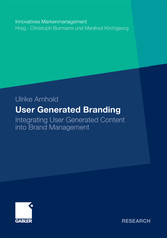Search and Find
Service
More of the content

User Generated Branding - Integrating User Generated Content into Brand Management
Preface
6
Foreword
8
Contents
10
Index of figures
15
Index of tables
18
Index of abbreviations
21
Index of symbols
25
A User generated branding (UGB) as a field of study
27
1 Relevance of UGB
28
1.1. Major shifts in the branding environment
28
1.2. UGB as a new challenge for brand management
35
2 Need for research
39
3 Objectives of the study
43
4 Outline of the study
46
5 Placement of the study in research theory
48
B Theoretical basis for the development of a UGB referenceframework
50
1 User generated content (UGC) as the subject of this study
51
1.1 Notion of content
51
1.2 Definition of UGC
53
1.3 Definition of brand related UGC
57
2 Identity-based brand management approach as the theoreticalframework of this study
60
2.1 Basic model ofthe identity-based brand management approach
61
2.2 Identity-based brand management process
70
2.3 Integration of UGB and brand related UGC into the identity-based brandmanagement approach
73
3 Relationship marketing as the practical reference of this study
77
3.1 Relationship marketing
77
3.2 Interactive marketing
78
3.2 Interactive marketing
78
3.3 Integration of UGB and brand related UGC into relationship marketing
80
4 Web2.0 and the digital world as context factors of this study
82
4.1 Advancements in digital technology
82
4.2 Web 2.0
83
4.3 Emergence of the digital community
84
4.4 Facilitation of legal schemes
85
5 Discussion and summary of the theoretical basis
88
C Specification of UGB
90
1 State of the art of research of UGB related concepts
91
1.1 User innovation research
92
1.2 Collective intelligence research
100
1.3 Word of mouth research
103
1.4 Community research
113
1.5 UGC research
122
1.6 UGB research in a broader sense
134
1.7 Discussion and summary ofthe literature review
149
2 UGB definition and differentiation from related concepts
152
2.1 Differentiation of UGB from neighbouring terms
152
2.2 Elaboration of detailed UGB definition
153
3 Application of UGB
157
3.1 UGB for the purpose of applied market research
158
3.2 UGB for the purpose of commercialisation and customer retention
163
3.3 UGB for the purpose of internal branding
172
3.4 Firm's stances regarding UGB and brand related UGC
174
D Development of the explanatory UGB model
178
1 Understanding of Causality
179
2 Reference framework for the explanation of determinants ofUGB attitude
181
2.1 Determinants in user-centric research fields
181
2.2 Derivation of hypotheses regarding UGB determinants
183
2.3 Specification of the conceptual model for UGB determinants
190
3.Refernce framework for the explanation of UGB effectiveness
192
3.2 Derivation of research hypotheses regarding UGB effectiveness
199
3.3 Specification of the conceptual model for UGB effectiveness
207
4 Summary of hypotheses and overall UGB model
212
E Empiric model validation and hypothesis testing
216
1 Research design
217
1.1 Study objects
218
1.2 Sampling and data collection
223
1.3 Data processing and editing
234
1.4 Sample statistics
237
2 Applied statistics for hypothesis testing
243
2.1 Descriptive statistics
243
2.2 Inferential statistics
245
3 Validation of inherent measurement models
261
3.1 Attitude toward the ad and attitude toward the UGB programme
261
3.2 Consumer-brand relationship
266
3.3 Attitudinal and behavioural effects
271
3.4 Programme related factors
274
3.5 User personality related factors
277
3.6 Discussion and summary of measurement model results
284
4 Validation of determinants of UGB attitude
287
4.1 Results of univariate UGB analysis
287
4.2 Results of bivariate analysis
290
4.3 Validation of UGB cause model
305
4.4 Discussion and summary of results of UGB determinants analysis
308
5 Validation of UGB effectiveness model
314
5.1 Validation of total UGB effectiveness model
314
5.2 Multi group comparisons based on partial UGB effectiveness model
319
5.4 Extra: Validation of internal UGB effectiveness model
342
5.5 Discussion and summary of structural model results
349
F Summary, critical consideration and outlook
356
1 Summary of the study results
357
2 Managerial implications
364
3 Critical consideration of the study results
368
4 Directions of future research
371
Appendix
373
Definition of Web2.0 and new media marketing terms
374
UGC examples from brand management practice
382
Questionnaires used within this study
392
Normality tests for explored latent variables
404
Original measurement scales referred to in this study
409
Comparison of bootstrap replications results
417
Validation of measurement models (add on)
419
Validation of determinants of UGB attitude (add on)
425
Validation of structural UGB effectiveness model (add on)
428
Validation of interaction effects (add on)
434
Bibliography
435
All prices incl. VAT












